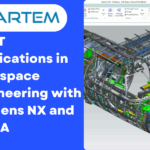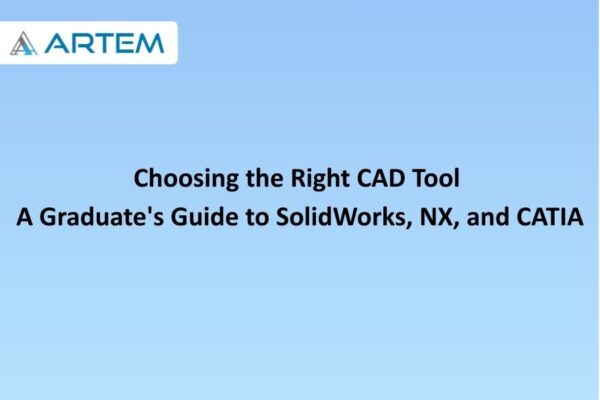Choosing the Right CAD Tool for Automotive Alignment Engineering: Siemens NX vs. CATIA
If you’re aspiring to carve your niche in the dynamic world of automotive alignment engineering, mastering Computer-Aided Design (CAD) is a crucial pit stop on your career journey.
The question then arises: which CAD software is the best companion for engineers in this field? Buckle up as we navigate through the options and unveil the ideal CAD destination for your automotive alignment career.
The CAD Landscape: Navigating the Options
The realm of CAD is vast, with various tools catering to different industries and design needs. When it comes to automotive alignment, two major players stand out: Siemens NX and CATIA
1. Siemens NX: Driving Precision and Integration
Why Siemens NX?
- Parametric Modeling Skill: Siemens NX is renowned for its robust parametric modeling capabilities. For automotive alignment engineers, this means the ability to create and modify 3D models with ease, ensuring precise alignment specifications are met.
- Integrated Simulation: In the automotive world, simulation is key. Siemens NX offers comprehensive simulation tools, allowing engineers to predict and optimize the performance of alignment systems before they hit the road.
- Collaboration and Integration: Siemens NX seamlessly integrates with other Siemens solutions, providing a unified platform for design, simulation, and manufacturing. This integration ensures a smooth workflow, vital for automotive alignment projects with multidisciplinary requirements.
2. CATIA: Streamlining Complex Designs
Why CATIA?
- Surface Modeling Excellence: CATIA is renowned for its advanced surface modeling capabilities. This is a game-changer for automotive alignment engineers dealing with the sleek and aerodynamic designs of modern vehicles.
- Collaborative Design: CATIA fosters collaboration, allowing engineers to work concurrently on different aspects of a design. In the context of automotive alignment, where various components must work in harmony, this collaborative feature is invaluable.
- Industry Dominance: CATIA has a strong presence in the automotive industry, making it a preferred choice for many automotive manufacturers. Learning CATIA can open doors to opportunities in major automotive companies.
Choosing Your CAD Vehicle: A Personal Journey
The choice between Siemens NX and CATIA ultimately depends on your specific career goals, the industry landscape in your region, and your personal preferences. Here are a few factors to consider:
- Industry Demand: Research the companies in your region or the ones you aspire to work for. Some may have a preference for Siemens NX, while others might lean towards CATIA.
- Learning Curve: Both Siemens NX and CATIA have learning curves, but your personal learning style might align better with one over the other. Consider exploring trial versions or introductory courses to get a feel for each.
- Future Growth: Look into the future development plans of each CAD software. Consider which one aligns with the evolving trends and technologies in the automotive alignment field.
| Aspect | Siemens NX | CATIA |
|---|---|---|
| Industry Adoption | Widely used in automotive and aerospace industries. | Prevalent in automotive, aerospace, and industrial design. |
| Parametric Modeling | Strong parametric modeling capabilities. | Robust parametric modeling with advanced features. |
| Surface Modeling | Excellent surface modeling for complex designs. | Known for advanced and precise surface modeling. |
| Assembly Design | Efficient assembly design tools with intelligent components. | Powerful assembly design capabilities with collaboration features. |
| Simulation and Analysis | Integrated simulation tools for structural, thermal, and fluid analysis. | Comprehensive simulation and analysis capabilities. |
| Collaboration Capabilities | Seamless integration with Teamcenter for PLM and collaborative design. | Collaboration tools facilitate concurrent design among team members. |
| Electrical Systems Design | Provides capabilities for electrical systems design. | Strong support for electrical systems design and integration. |
| CAM (Computer-Aided Manufacturing) | Integrated CAM solutions for manufacturing processes. | Extensive CAM tools for a range of manufacturing applications. |
| Industry Standards Compliance | Compliant with industry standards like ISO 16792 (STEP AP242). | Known for compliance with various industry standards. |
| User Interface | User-friendly interface, easier for beginners. | Interface design may have a steeper learning curve. |
| Customization and Extensions | Extensive customization options and a wide range of extensions. | Offers customization options but may have fewer extensions. |
| Cost Consideration | Licensing and maintenance costs can be relatively high. | Cost structure may vary, and licensing costs can be significant. |
Conclusion: Steering Toward Success
As you rev up your career in automotive alignment engineering, remember that both Siemens NX and CATIA are powerful tools with unique strengths. The best CAD for you is the one that aligns with your career goals, the industry landscape, and your personal preferences. So, buckle up, choose your CAD vehicle wisely, and enjoy the ride toward a successful and fulfilling career in automotive alignment engineering.





